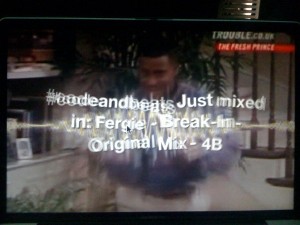I mentioned in a previous post that I was going to Code And Beats. I could’ve worked on work work. I could’ve worked on non-work work. But I didn’t do either. Instead, I experimented with some visual effects in Flash — combining video, audio input, and tweets.
By 2am, here’s what I had come up with! (I’ll post the code soon eventually)
Code & Beats: Music Powered Twitter Wall from Brian Shaler on Vimeo.
Fun stuff! I’m interested in seeing this event come to Phoenix. We just need to get the organizer (+developer +designer +DJ) Avi to fly out and then round up a few local DJs with some good electro material. Un tiss un tiss un tiss…
Also, here’s a separate pic I snapped of the Twitter wall:

I should’ve put together a video showing more of the background dancing clips. Some of them were pretty excellent!
